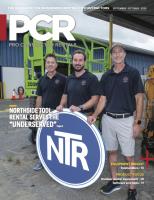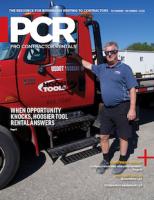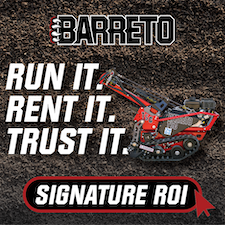Build Your Business -- Telematics-based fleet management
How today’s OEM telematics systems can help improve efficiency and profitability.
by Misty Mason
 |
| JLG’s ClearSky telematics system offers two service plans: One provides a customizable dashboard portal that allows users to see the data points they care about most; the other plan integrates raw telematics data into a company’s existing rental software or ERP system. |
In the construction and industrial maintenance industries, businesses rely on equipment rental companies to provide the machines they need to successfully complete certain tasks but don’t use often enough to justify purchasing.
That means rental companies are often sending expensive, complex machines to remote work sites where the machines’ use and maintenance are no longer under their control for weeks or months. As a result, equipment rental companies incur a significant amount of risk each time a machine goes out on rental from possible loss and damage to potential equipment health and scheduling issues.
Proper fleet management can have a tremendous impact on an equipment rental company’s overall fleet health, stability and profitability.
Equipment fleet management is often divided into five primary segments:
• Operational efficiency;
• Operational cost effectiveness;
• Operator management;
• Equipment maintenance; and
• Equipment safety and compliance
Rental businesses must consider all five factors carefully to get the most from their rental fleets.
“Fleet management means different things to each of our customers,” says Korry Kobel, director of engineering for JLG Industries Digital Solutions teams. “Our goal is to support each of them with the right information and connectivity to support their individual business needs for their rental fleet. That includes offering a telematics-based fleet management tool, like our ClearSky telematics and Access Control system.”
Justifying telematics
In some ways, telematics technology has made fleet management easier for fleet-based operations. JLG introduced ClearSky in 2008, launched a simplified version based on customer feedback in 2017 and, in February 2019, enhanced the system to include ClearSky Access Control, an optional tool that allows rental companies to safeguard their machines and prevent unauthorized personnel from accessing equipment.
Other OEM-based systems have also changed over the years, offering new features that fleet managers have come to value and depend upon. However, while many construction companies have increasingly integrated this technology to monitor vehicle and equipment location, fuel consumption, maintenance, and operator behavior, rental businesses have been slower to adopt it.
“I’d estimate that a minority of rental companies are now actively using telematics for fleet management,” says Kobel. “The cost/benefit ratio can be a real-world hurdle for rental business owners and the overall costs of such a system are not always captured by the telematics system itself.
The benefits may be less obvious when standard assumptions and practices are not evaluated with the right lens. Change is hard and questioning how things have been done for years is not always easy when very real dollars are obvious costs. There are also issues associated with managing mixed fleets that make it somewhat difficult for a rental business without a dedicated IT department to support a telematics-based fleet management system.”
There are numerous benefits that can justify the initial time and effort. Appropriately timing regular and preventive maintenance, in particular, is a challenge that rental companies face every day. Equipment rental periods often last weeks or months, and that equipment must be maintained while out on rental. Because rental businesses provide value by renting out equipment that operates as expected and without interruption, they must ensure their fleets are in top condition. This ensures that customers avoid unexpected downtime, lost productivity and the related cost implications.
Typically, most construction jobs run on tight margins and workers must often complete one part of a project before they can start on the next. If equipment breaks down or requires service while on the job, entire projects can fall behind. Customers may move rental equipment from the original delivery site, making it difficult for rental companies to locate units and service it in an efficient, timely manner. Telematics can help address these challenges by giving rental companies visibility to equipment location and operating condition at any time.
Access to actual asset utilization metrics, including engine hours, as well as geo- and time-fencing are also key factors for most rental companies. “Some rental companies have told us that avoiding just one field service call or one ‘lost’ machine is enough to make a telematics system worth it,” Kobel says. “Being able to compare telematics data to the original rental agreement and determine whether a customer complied with that agreement is a major benefit of telematics-based fleet management.”
Best management practices
Rental companies that invest in a telematics solution are taking an important step to improve its fleet management; the next step is establishing best management practices to make the most of the investment.
“Every rental company – or any fleet-based company, for that matter – should talk to its top OEM partners before deciding on a telematics solution,” Kobel says. “Find the one that makes the most sense to partner with long-term, and then move forward.”
Even before approaching an OEM partner, rental companies should make a concerted effort to understand their own fleet management needs and concerns. Note specific, real-life situations that presented a fleet management challenge or issue to help rental companies develop clear objectives. Those objectives will help prospective OEM partners determine how their telematics solution will address the identified needs.
“After choosing an OEM partner, rental companies can work with that partner to develop an implementation strategy that includes data capture, analysis and management,” Kobel says. “OEM solutions will range from basic to more complex depending on the customer’s needs and fleet size.”
Information/data points are only helpful when it’s put to use. Rental companies need to work with their OEM providers to get the right data, integrate it into useful reports and then use it to help make critical fleet management decisions.
“For example, JLG’s ClearSky telematics system offers two service plans: One provides a customizable dashboard portal that allows users to see the data points they care about most,” Kobel says. “The other plan integrates raw telematics data into a company’s existing rental software or ERP system. It’s all about creating a seamless system that gives the information they need in the manner they want to receive and consume it.”
That data needs to contribute to long-range business goals and improvement strategies that could help grow rental customer base, offer better machine familiarization at the start of each rental, limit the geographical radius in which machines may be used and decreasing the number of jobsite service calls.
“The best of maximizing telematics and access controls is yet to come,” Kobel says. “The future is very bright for this exciting field, and we’re going to see even more functionality and fleet management benefits for our customers in the years ahead.”
Misty Mason is senior product management analyst at JLG.
This article originally appeared in the July-August 2019 issue of Pro Contractor Rentals magazine. ©Urbain Communications,LLC. All rights reserved.










